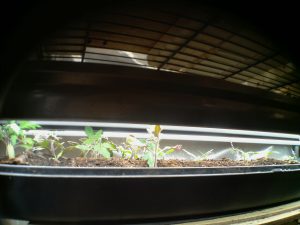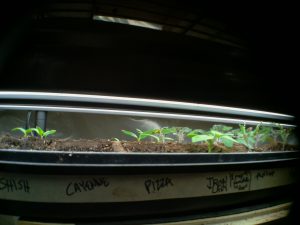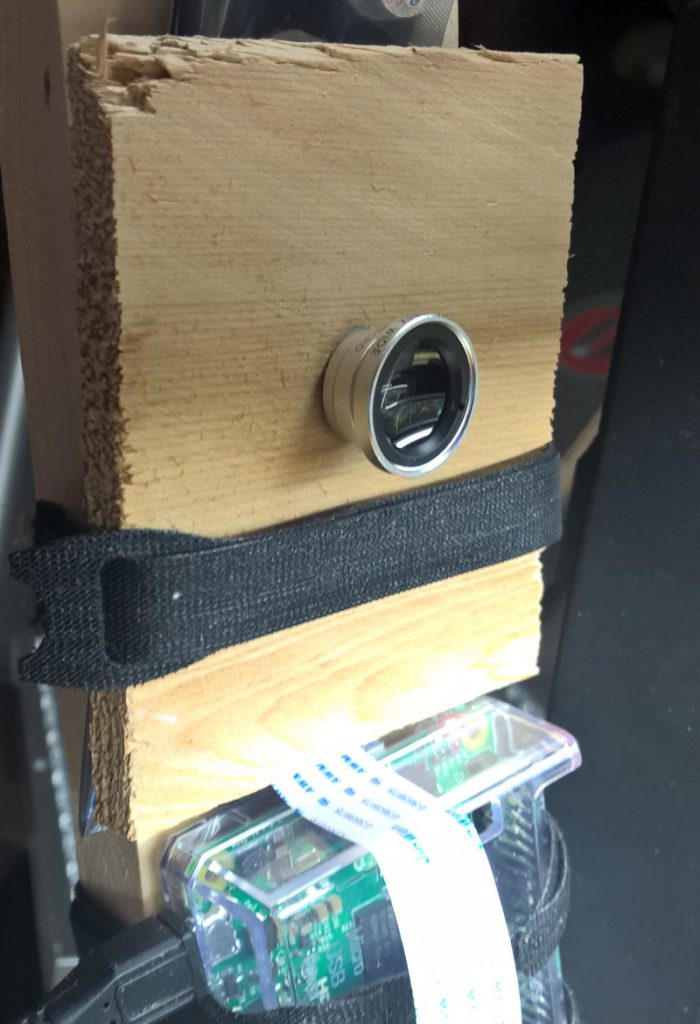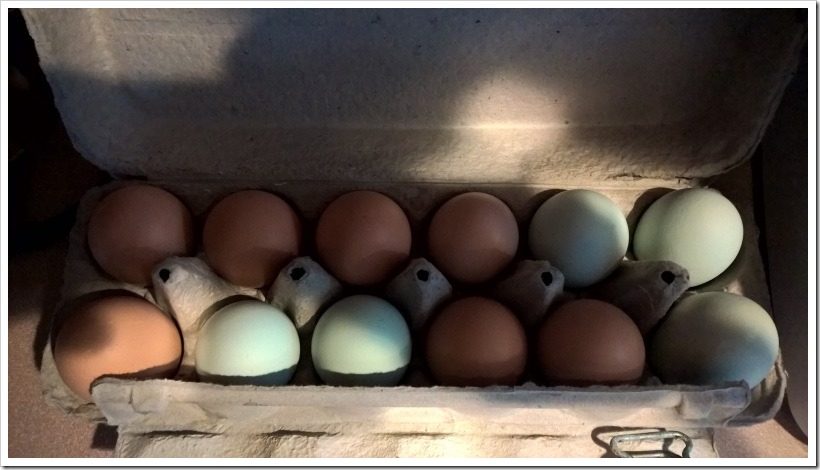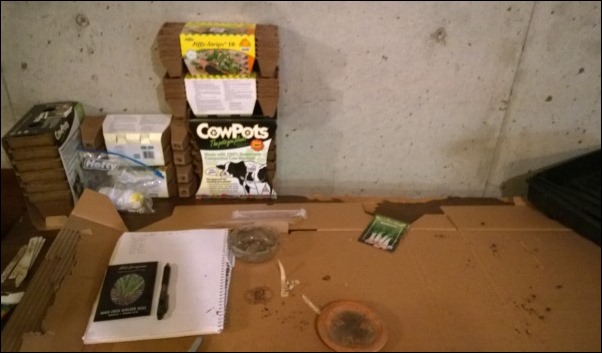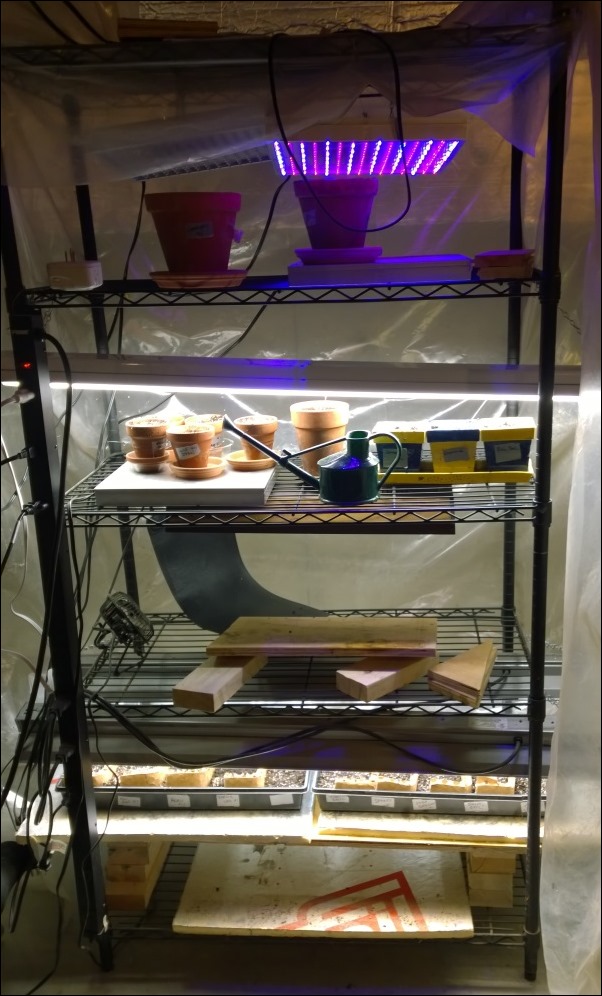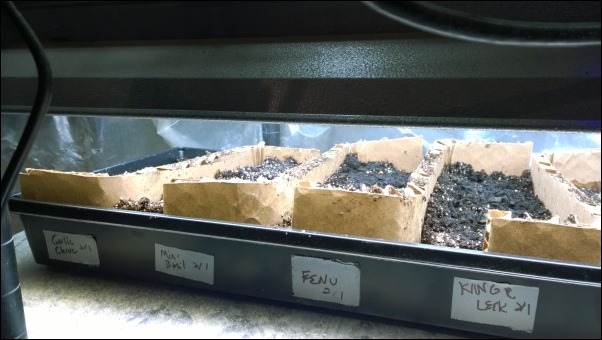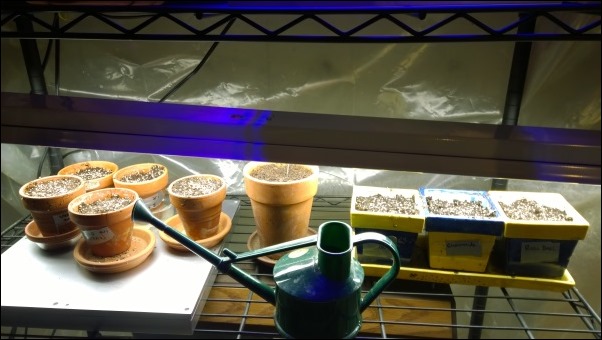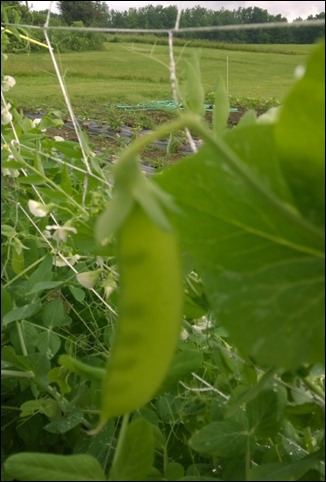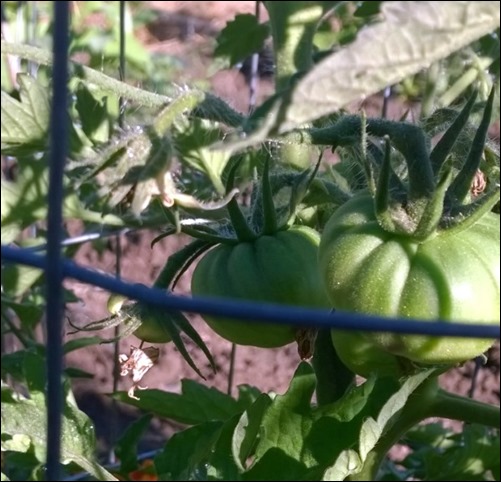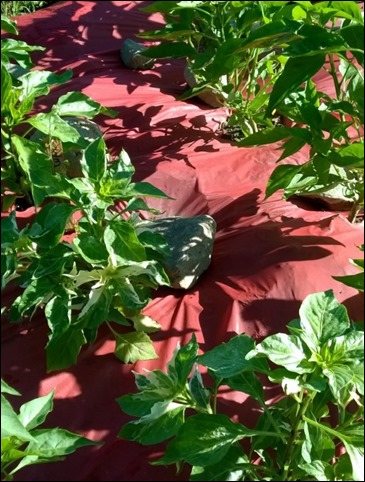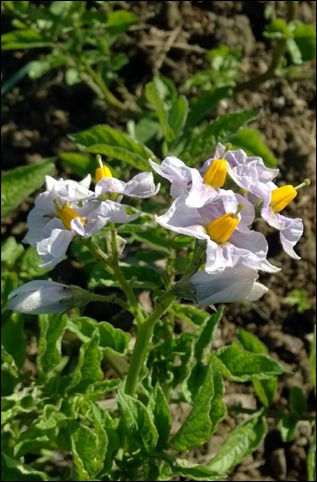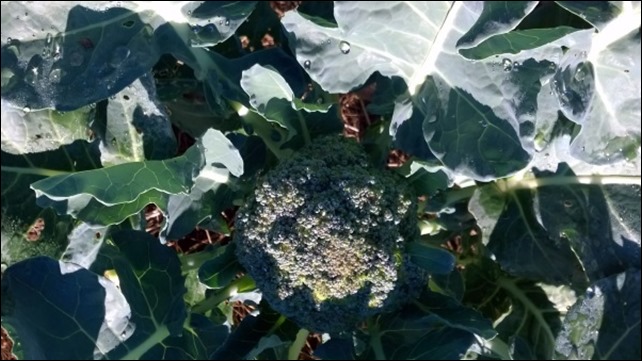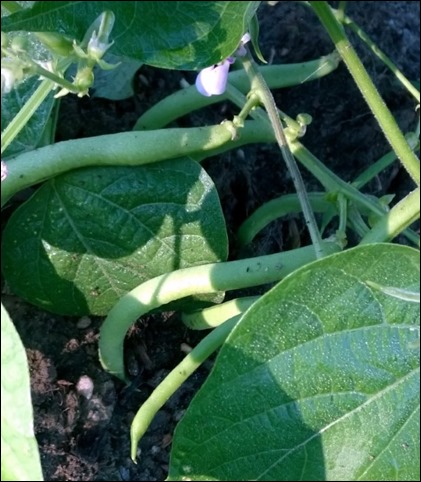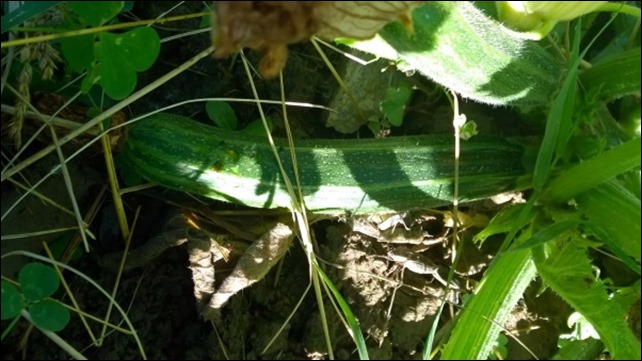Current state of the tomato seedlings, automatically posted from my Raspberry Pi 2 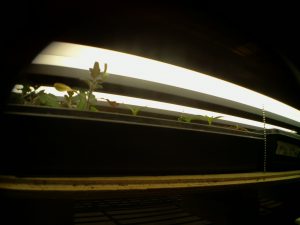
Snapshot of the seedlings on Wednesday, April 15
Snapshot of the seedlings on Tuesday, April 07
First time lapse video of pepper and tomato sprouts
As I mentioned in my last post, I’m working on a project with the Raspberry Pi 2 and one of the things I’m doing is playing around with the camera module.
This little camera is not bad (similar to a cell phone camera), but it definitely does best at a bit of a distance. Probably 6-10 feet at least. I need to be a bit closer to get enough detail and also due to the limited spacing between the grow lights and the seed trays. I ended up picking up one of those cheap little sets of lenses you can get for cell phones. It’s not going to win fine photography awards, but it’s just fine for my needs. The kit includes a fisheye, wide angle, macro and telephoto lens. Here’s a closeup of one of the lenses in place.
My camera mount is a very primitive holder I threw together out of scrap wood, but it does the job.
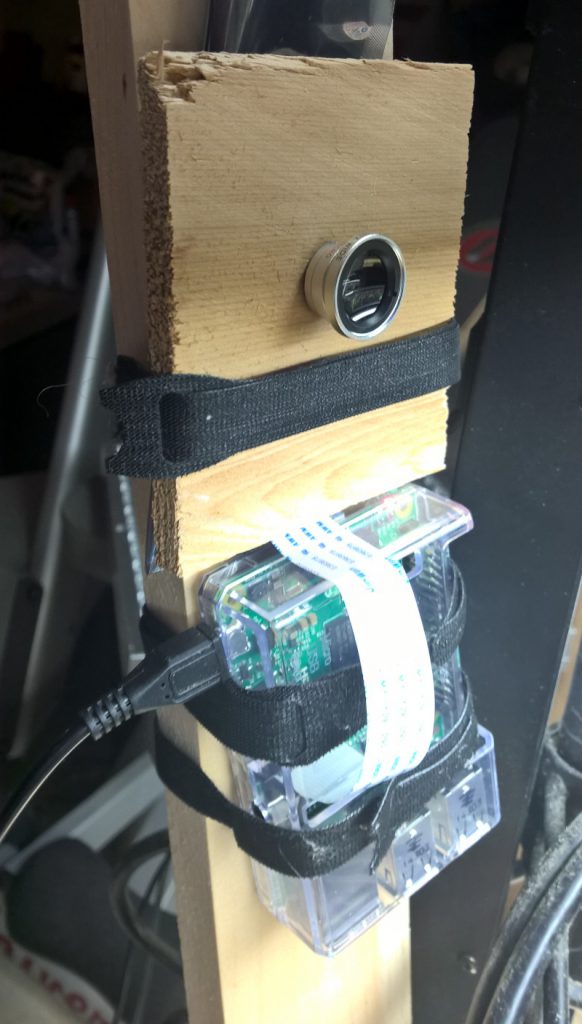
Here is a wider shot of the seed starting area with the camera mount in place. I have it taking photos every 30 minutes of one of my pepper and tomato seed starting trays.
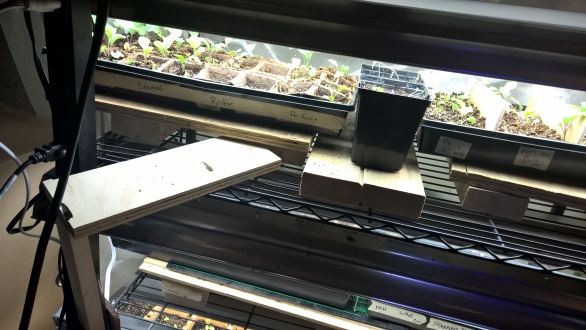
Here is an initial time lapse video showing some of the seeds sprouting and growing. This was taken over the course of 5 days, March 26-30. I do change the camera position and seed tray position slightly, so it’s a bit jerky in spots.
Initial thoughts on the Raspberry Pi 2
Note: This is more of a technical post that I am also posting to my work blog, but since I am a software developer as well as a homesteader this is an interesting cross-section of my two worlds. Most farmers I know are tinkerers, inventors, DIY-ers and improvisers, so this fits right into that line of thinking.
When the Raspberry Pi first came out a few years back, it seemed like a very interesting idea in theory. A tiny computer for $35, completely self-contained, with built-in Ethernet, HDMI and a couple of USB ports. It peaked my interest briefly, but I never got around to trying it out.
Fast forward to 2015 and there’s a new model with a quad-core processor and more memory, which translates into better/faster video options and a lot more power in general. There are plenty of articles discussing all the ins and outs of the new model, but a couple of things made me take a look this time.
One, Microsoft has promised a version of Windows 10 (out in preview right now) that will run on the unit. This opens up all kinds of possibilities for someone who is already intimately familiar with the Windows development eco-system. I do love working with Linux, but the first part of this sentence is a lie. Guess I just lost any geek cred I was building up. I’ve dabbled in Linux on and off over the years and I think the biggest issue is that I’ve never spent enough time in it to get comfortable. So everything I want to do involves a trip to Google.
Two, my company Clarity is sponsoring a concept called Ship Days this year where each employee is expected to “ship” some little side project during the year. It’s pretty wide open, but could be a mobile app, an Internet of Things project or something you might see at a MakerFaire event. Suffice it to say I won’t be the only one taking a fresh look at the Raspberry Pi platform.
I’ve had the Raspberry Pi 2 for a couple weeks now and here are some random thoughts and impressions.
- Since conception the Raspberry Pi fairly quickly became a hacker/tinkerers dream platform. That means there are all kinds of add-ons available, the set up process has gotten drop-dead simple and there are tons of tutorials, blog posts and ideas out there to peruse.
- The Raspberry Pi 2 model mostly changed in how much power is on the board, so pretty much anything that worked with previous models will work with this one. In some cases you might need an adapter cable to hook up the proto boards or shields, but most stuff is fine.
- The “NOOBS” set up experience gives you lots of options, including ones geared to specific uses like as a media center PC. I was up and running in no time on the most common distro (Raspbian) which is a version of Debian Linux.
- The unit doesn’t really like hot-swapping USB very much. I managed to corrupt my first install pretty easily and had to start again. If I understand correctly, part of this is due to using the SD card as your main boot disk, which is much more sensitive to I/O disruption than a traditional hard disk.
- There are tools that make is easy to pop your SD card into your main computer and make a clone of it when everything is working the way you want, so that is certainly a good idea when working with this unit.
- The networking stack seems a bit flaky with wireless. I got the highly recommended Edimax nano usb adapter, but I’m still having trouble with getting the unit to respond consistently to SSH or RDP requests. I put in a job to restart networking every hour or so and that seems to have helped.
- I got the Raspberry Pi camera module and it is extremely easy to work with. Right now I have it taking time-lapse photos of one of my seed starting trays. This tutorial worked great and it’s really simple to get working. More details on this in later posts.
All in all it’s an impressive little piece of engineering, particularly for $35. There are lots of possibilities for automation and monitoring that might be interesting to try on my little hobby farm. Many folks are already using a Pi or Arduino along with sensors to automate plant watering for instance. I bought a couple of moisture sensors that I’m hoping to get hooked up eventually, but as that requires some soldering it involves a bit more time to get up and running. I’m hoping to tackle that next.
Finally getting some eggs
After a long winter with little egg production, things are finally looking up. Some of our new hens never came “online” last fall and ended up waiting until this year. But since Wednesday morning, we’ve gotten 17 eggs including 2 already today. That’s from 9 hens. Based on the color of the eggs, it looks like at least 6 hens are laying some of the time.
Trying to grow some lemongrass
Seed starts
Well, it’s already that time again. Starting seeds marks the beginning of the gardening year. We already have most of our seeds ordered. It’s still a bit early to start most things, but I am starting some herbs and flowers since they can sometime take awhile to get going and actually will do ok inside for a few months.
I’m also hoping to buy a small greenhouse this spring, so I’m hedging my bets that I’ll be able to move some things out there and get them acclimated with more true daylight earlier in the season. Should lead to more robust starts that can be planted sooner.
Here’s our seed starting space in the basement.
Here is a full view of my growing rack. I would like to add a few more lights this year.
This year I’m trying to start some seeds more by broadcast right in the tray and then transplant the viable starts into the individual cell trays that we usually use. The cell trays have been problematic because typically not all the seeds germinate. So you replant and have seeds at different points of progress or you forget whether you’ve re-planted or you wait several cycles for germination and so on.
Some of the flowers and herbs I’m doing directly in a small pot instead. The small green watering can you see in the photo has worked great, it has a very small spout and face that is very gentle on young plants. Highly recommended as this is much easier than trying to use a spray bottle. You can get it from Amazon.
Next up in a few weeks, brassicas, tomatoes and peppers.
2014 Year in Review
Well, between keeping up with all the projects and having a new baby, this blog has taken a bit of a hit. So this post won’t be too lengthy, but wanted to do a quick bullet point list of stuff we managed to accomplish this year.
- Poultry
- Built a brand new chicken coop based on Fresh Air Poultry Houses, large enough for 15 chickens or so.
- Lost one of our original hens, but picked up 6 new ones.
- Got our first blue eggs.
- One of the 6 new “hens” turned out to be a rooster (the Cuckoo Maran). He is still on probation until we determine if he’s going to be nice and helpful or a pain.
- Built a duck coop and planned to get ducks, but that didn’t happen this year. Hopefully next year.
- Set up solar for the new coop, which I still hope to blog about at some point. It’s struggling a bit now with the limited daylight and snow/ice, but I think overall will work well for lighting. Would eventually like an automatic door as well.
- Gardening
- Put in 2 brand new garden plots. They did okay considering it was the first year, although we still have a lot of soil consistency and wetness issues to work on.
- Started 4 blueberry bushes, 25 asparagus crowns (of which about half made it) and 75 strawberry plants (3 different varieties of 25 each).
- Had some luck for the first time with the following this year
- Melons
- Pumpkins
- Leeks
- Eggplant
- Gourds
- Popcorn
- Sweet peppers
- Standouts included
- Potatoes (despite web conditions and compacted soil)
- Brassicas (broccoli, cabbage)
- Some of the tomatoes
- Soybeans
- Flowers – we had decent luck with various flowers this year, including sunflowers, that we’ve struggled with before.
- Peppers, although I always want more variety and quantity
- Still can’t seem to get Brussels Sprouts to work.
- Our cucumbers and squashes mostly succumbed to a vicious onslaught of insects. Need to do a bit more row cover and other stuff next year.
- Landscape and other property work
- Got a riding mower and shed to store it in.
- Planted 4 apples trees.
- Had a full landscape design done that we are really excited about implementing over the next 5-10 years.
- Built 2 bay compost bin
Lots of plans for next year that I may get into in another post. Soon it will be time to buy and start seeds. By the way, if you are thinking about seeds, don’t forget about my new site PickAPacket.com and tell your friends. It allows you to compare prices and see varieties carried by 13 of my favorite non-GMO seed companies, including lots of heirloom, organic and open-pollinated varieties.
State of the garden
Well, it’s already July and I’ve been so busy working I haven’t had much time to blog about it. The short story is our gardens are overall doing fairly well, considering it is the first year. We are certainly fighting weeds, but that happens regardless. The soil structure is definitely better in the front garden, where we dug up a spot that was more hay pasture than lawn. Both need a lot of work, particularly when dry. After a rain though, the soil really isn’t too bad and I think with some tender loving care in a few years we’ll start seeing some pretty good structure.
We had a chance to plant more peas this year and focused more on sugar/snap peas, since you get a lot more for the space and they are easier to freeze for later. Ezra has taken a big liking to peas, particularly shell peas which he eats raw by the handfuls. On most days he has to go “check his peas” and is actually already doing a pretty good job at learning when they are ripe. It’s pretty cute.
It’s been pretty interesting to see the difference having lots of direct sun makes. It’s mostly a good thing, although we had a couple of issues with transplanting where the plants got some sun scald. We’ve always had to worry more about wind or temperature than sun before. The tomatoes I am especially happy with and we’ll see if the actual harvest lives up to the expectation. But this is the first year I’ve been relatively happy with my tomato (and pepper) starts. We should start seeing some ripe tomatoes here shortly, there are a bunch off small green ones on the vines.
Here are some nice jalapeno plants, with some sweet basil in the background.
More peppers, including the “fish” peppers in the foreground. We use red plastic mulch to help reflect more of the good light spectrum that peppers (and tomatoes) love. Still trying to determine how much difference it makes.
Potatoes are coming along nicely and we had our first red new potatoes the other night. We have a nice variety planted, including several different fingerling varieties. This year we decided to try seed potatoes from Wood Prairie Farm in Maine. Jim Gerritsen has a reputation as one of the top organic potato experts in the country, so curious to see how these do. I think this may be a hit and miss year, with the soil structure not being super loose the way potatoes like.
A lot of folks don’t realize potato blossoms are some of the prettiest flowers you’ll ever see in your garden, check out this fingerling variety in bloom right now.
Here are a few other things that are starting to come into harvest. This is the time when all the hard work starts to pay off and you actually see some results from the labor, so I love this time of year.
One of our first broccoli crowns.
First bush beans, a variety we discovered last year and really has become one of our go-to beans: Provider
And of course the first of probably too many zucchini.

